Basketball drills for technique defense
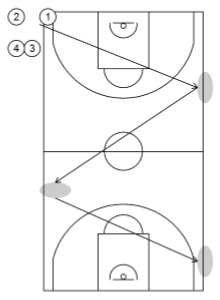
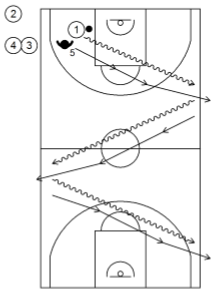
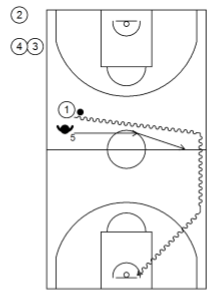
Requirements:
Players must be able to sprint and slide and switch between them Â- Players must be able to dribble
Goal: Press
the dribbler on the press
Organisation:
Have each player sprint fully along the drawn lines and always close off the touchline (set up cones) idem but now with slides idem with alternating slides - sprint - slides Â- attacker without ball. Defender must make slides as long as possible; sprint if necessary Â- defender must close off the sideline in any case Â- same with ball. Defender forces attacker to turn on the sideline Â- keep exercise short and intense
Teaching points:
defender should get as close to attacker as possible, taking into account dexterity and speed of dribbler Â- defender should close off sideline with foot, forcing dribbler to turn Â- defender should accelerate, get in front of dribbler before closing sideline
Form of play:
if the dribbler manages to dribble between the sideline and the defender, then he may score Â- defender then continues to defend Â- if the defender manages to make the attacker turn at the sideline then he may then dribble and the attacker becomes defender
Tips:
start with a weak dribbler and let him start with his weak hand Â- impose restrictions on the attacker in the beginning: he can only change speed, but not direction, except on the touchline Â- reduce the restrictions as the defenders get better
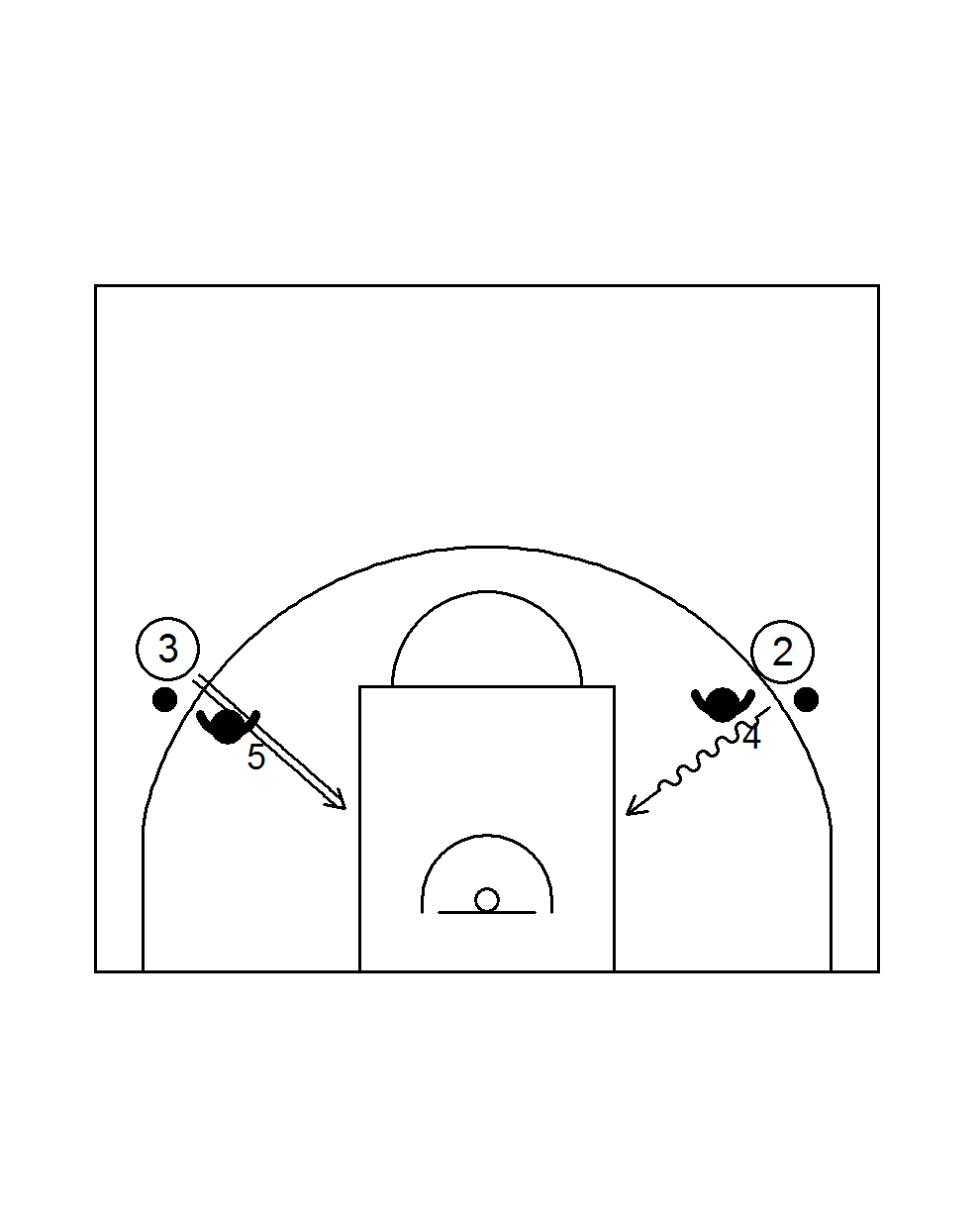
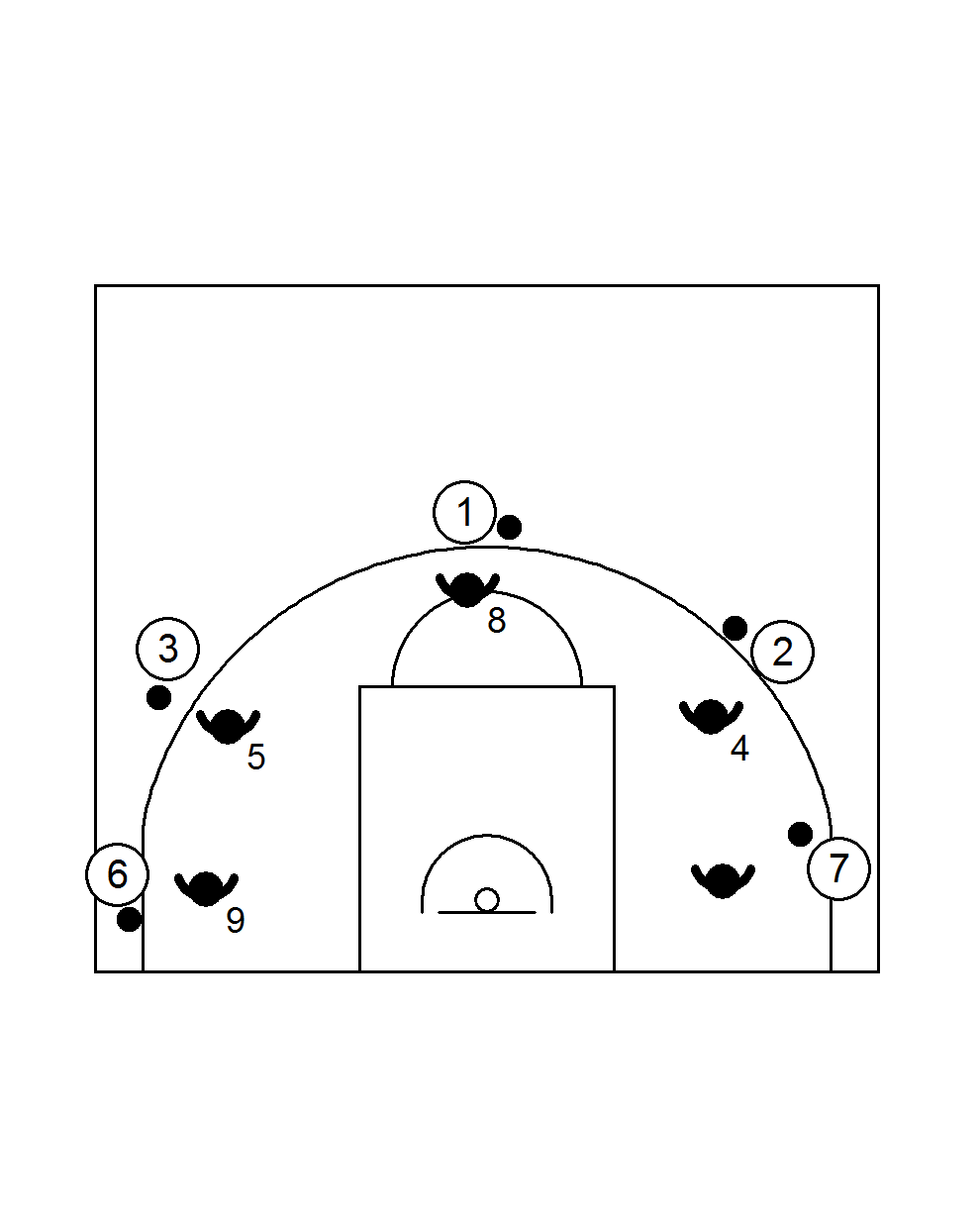
Goal: Defending the forward in triple threat position
Organization:
- attacker makes an agreed number of different feints before shooting or dribbling to the basket
- defender must anticipate with a drop step when the attacker threatens to go over the front foot
- with a two-footed backward hop when the attacker threatens to go over the back foot
- when the attacker brings up the ball, the defender should quickly step towards the attacker, stand against him, feet wider than the attacker,
- Trace the ball with your hands
- When the attacker brings the ball back down, the defender returns to his/her original position with a slide step or a hop backwards (arm's length distance)
Teaching points:
- react quickly on the feet, before the attacker does
- Distance from the attacker: match the threat he poses.
- Shorten the distance to the attacker with mini-slides, so that you can react immediately
Variations:
attacker gives a pass to himself from the bucket edge
Starting exercise:
- defender starts at arm's length
- Square up = feet next to each other, chest perpendicular to the line of the ball-basket when the attacker is standing on the axis of the field.
- Left foot forward when the attacker is standing on the right half of the field and vice versa.
- Attacker fakes the shot
- Defender steps forward, hand on ball
- Attacker brings the ball down
- defender recovers arm-length distance
- attacker makes max 2 dribbles, left or right
- after the stop, the defender steps forward again, hand on the ball
Form of play:
- as above, but with shot + boxing out (= wall and rebound)
- 2 scores in a row (also from the rebound!!) OR 2 stops in a row = loser presses and change
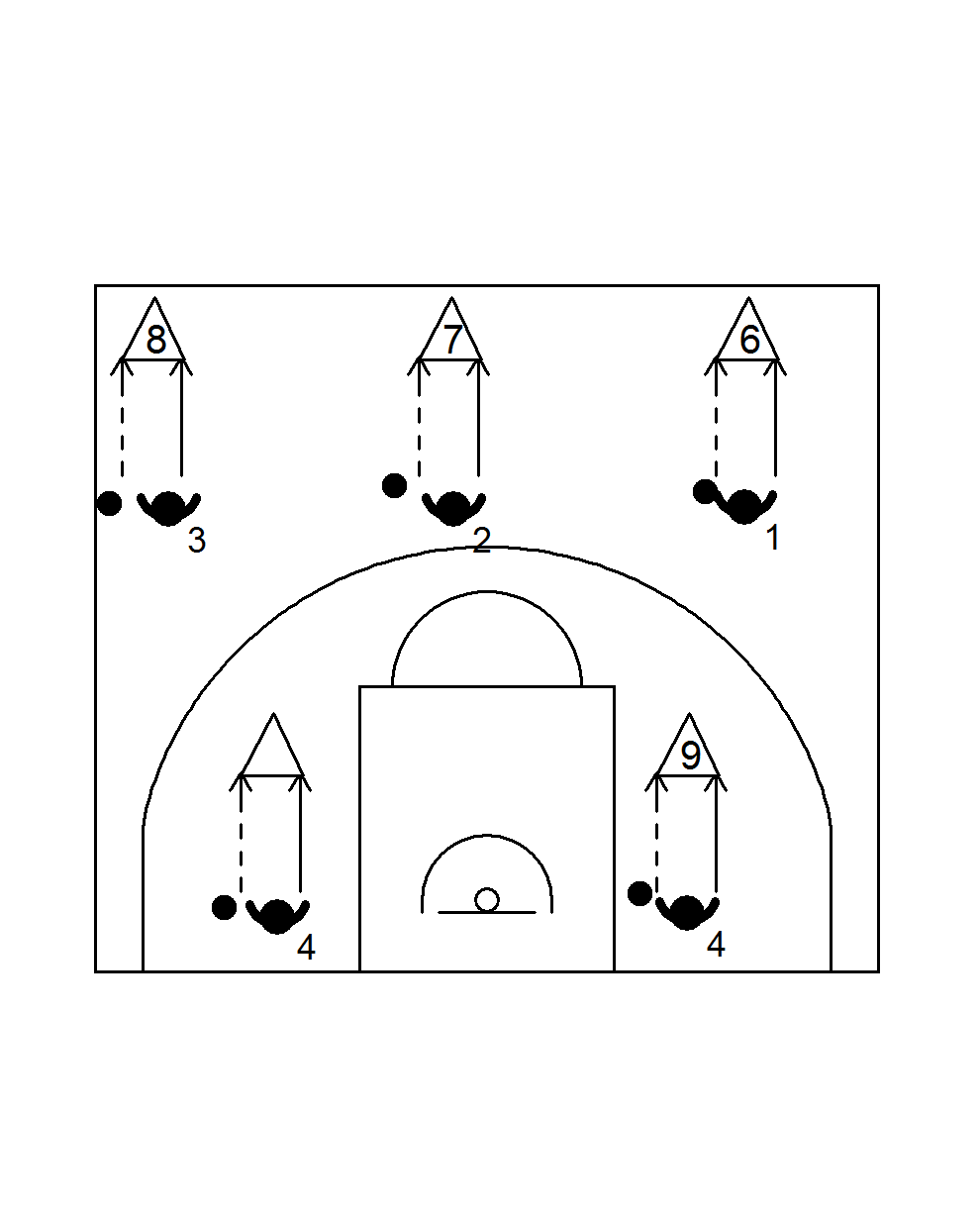
Goal: defend the dribbler after stopping the dribble
Organization:
- man with ball passes to opponent when trainer whistles
- who takes 1 bounce and stops the dribble in 2 Count Rhythm (2TR)
- The trainer counts down 5 seconds and then blows his whistle as end signal
- The aggressive defender steps back to his starting position
- The roles are now reversed
- As soon as the trainer whistles you pass the ball to the other player
- go for it aggressively straight away
- Try to prevent the other player from passing by keeping your hand in front of the ball (trace the ball)
- Try to get your feet to the left and right of the pivot foot of the man with the ball so that he cannot turn
Teaching Points:
- avoid mistakes; do not hit the ball
- Go for the 5 seconds
- Get as close as possible to the attacker (but stay in your own cylinder)
- Move your feet closer to the attacker, but keep your position between the attacker and the basket.
Variations:
- a third man to whom the ball must be passed within 5 seconds. Choose a limited area in which the third man can run free (use lines on the court, or place pawns).
- Pass from under the board to the player on the block. This player must try to pivot past the defender and score. Winner becomes attacker on the block, loser passes from the back line.
Form of play:
- Ten ball on the half court, where the receiver of the ball has to make a dribble start with 1 bounce before he can pass the ball on.
- idem, but defence MUST double team the man with the ball.
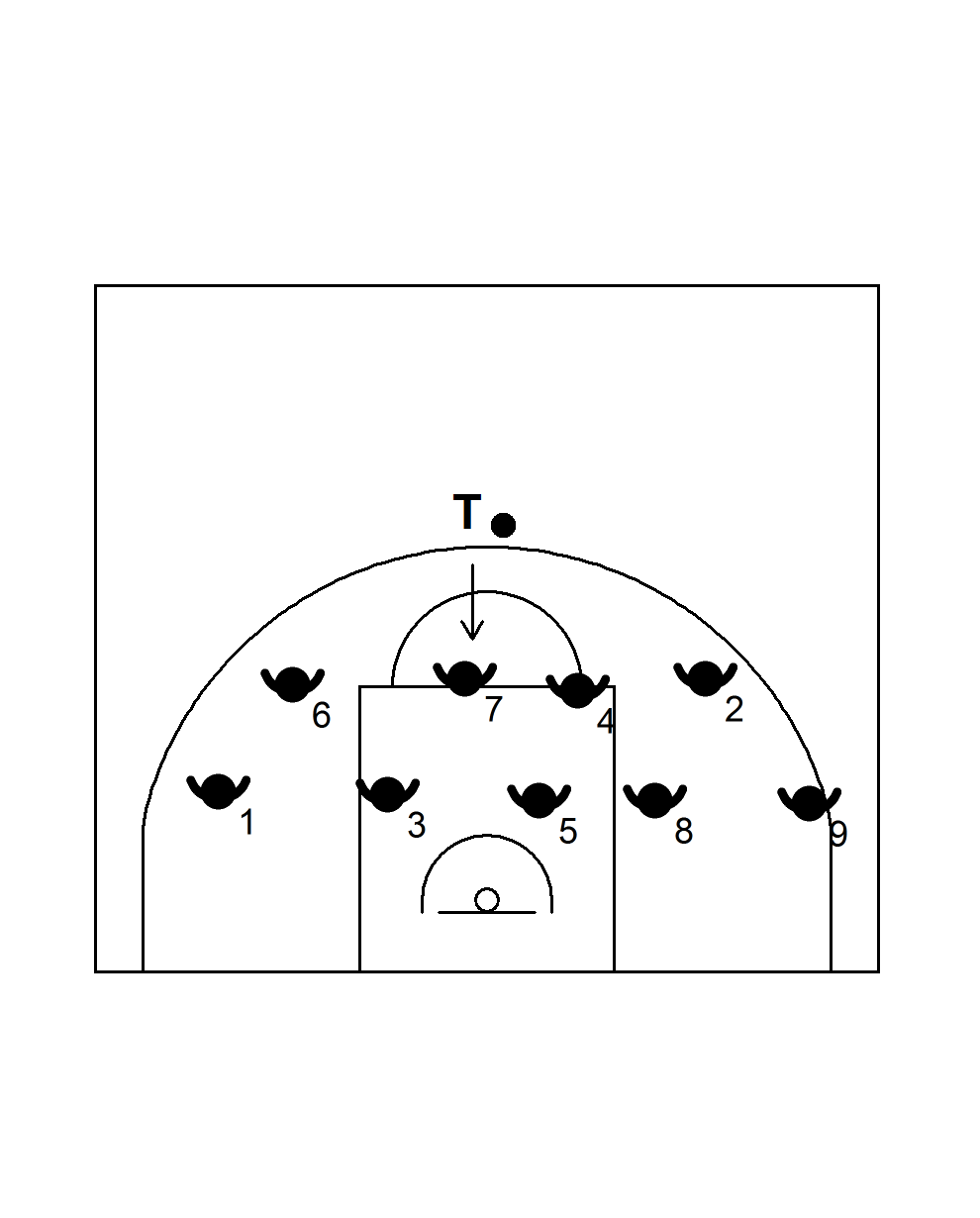
Goal: teach defenders how to catch the attacking foul (= penetrate or charge) (and how to handle physical contact)
Principles:
- when the attacker gets closer, move your feet further apart and lower your butt
- Hard forearm across your navel for protection.
- Always land on both buttocks.
- Land in the direction of penetration.
- roll to your shoulders and bring your legs up for protection
- DO NOT catch with your hands to avoid broken wrists.
- scream while falling
Preparatory exercises:
- players line up in defensive stance
- Trainer walks forward
- players put their feet outward, bring the hard forearm in front of their navel and lower their buttocks
- Trainer shouts "charge".
- players fall and roll on
defend the dribbler
- the trainer makes a zigzag movement
- the players make slide steps and drop steps as if they were defending the dribbler
- as the dribbler approaches, players move their feet outward, bring the hard forearm in front of their belly button and lower their buttocks
- trainer calls 'charge
- players fall on both buttocks in the direction of the penetration and roll through
spin dribble
- the trainer simulates a spin dribble
- players take two quick slide steps around their imaginary attacker, land wide, bring the hard forearm in front of their navel and lower their buttocks
- Trainer calls 'charge'.
- players fall on both buttocks in the direction of penetration and roll through
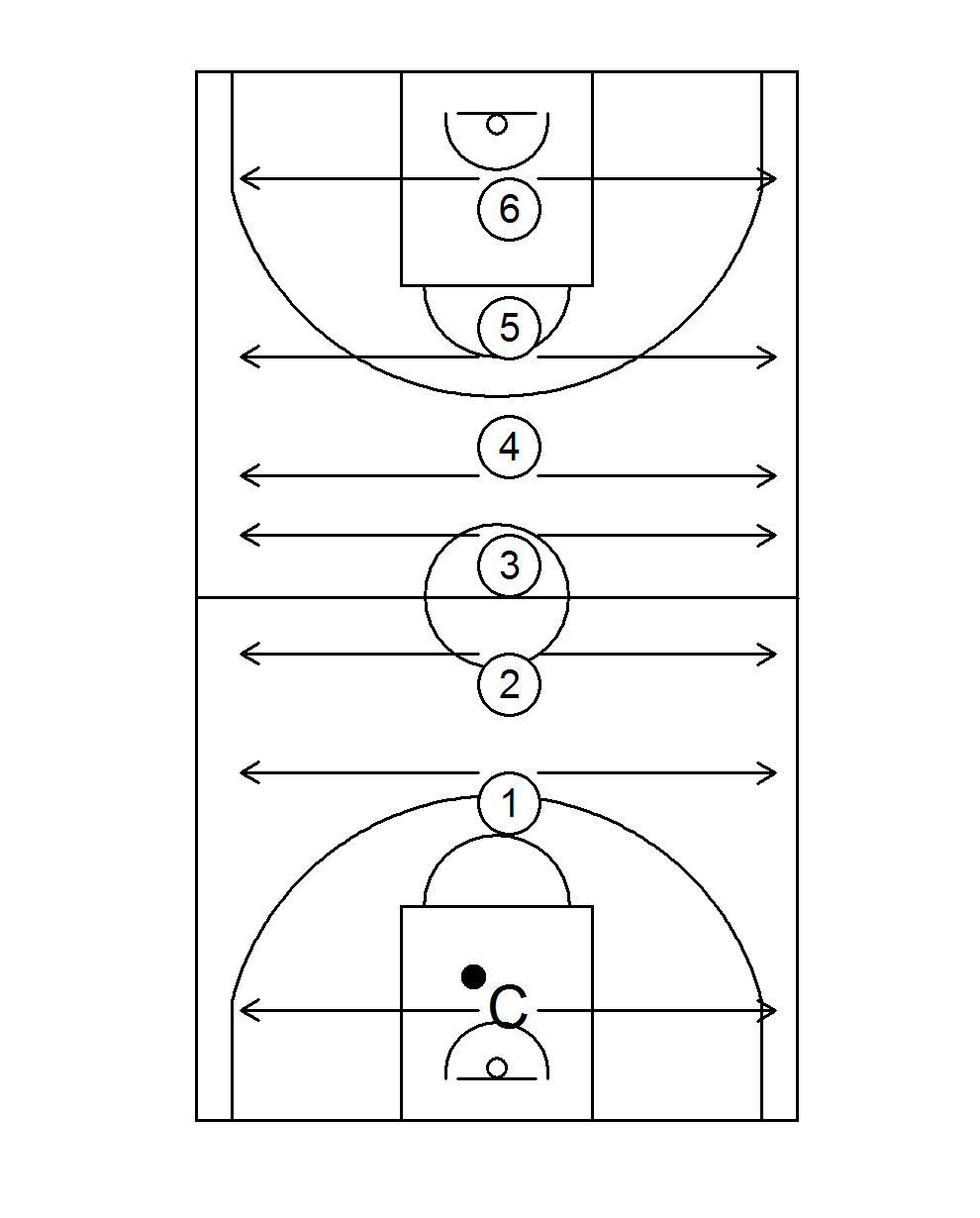
Goal: learn or improve side slides + condition
Organization:
- all players on the helpline, facing the coach
- when coach bounces the ball all players jump into defensive position
- coach moves to the left or to the right, parallel to the backline
- players must stay with their face right in front of the ball
- increase the level of difficulty by changing direction and/or speed at random
Teaching Points:
- feet at least shoulder width
- knees at about 100 degrees (= sitting down deeply)
- shoulders above the heels (= back straight)
- Head upright (overlook the field)
- Hand closest to the ball is low (to be able to tap the ball away on the dribble)
- Other hand is above the shoulder (to intercept a pass)
- push hard on the push-off leg to gain speed
- Feet stay low to the ground (= slide, shuffle)
- feet do not connect after a slide, but remain at shoulder width
Variations:
- let the defender keep his hands on his back if you want to accentuate the feet and stance.
- 1 slide and back to the sideline, 2 slides and back etc. until you reach the sideline; followed by a short fierce sprint back to the sideline
- first a drop step and then slides backwards to the sideline + sprint back
- idem, but first a little tap (quickly transfer weight from one foot to the other)
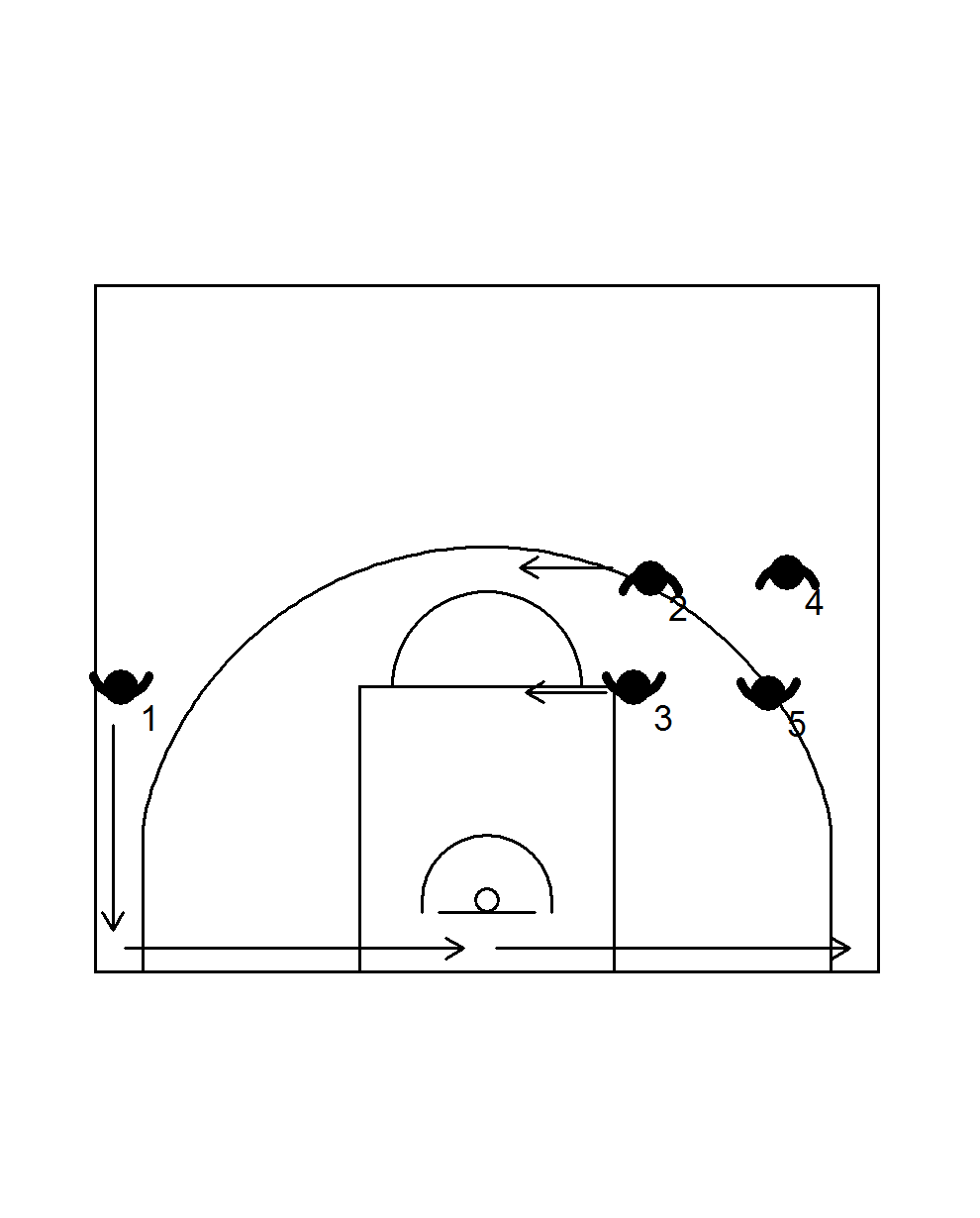
Prerequisites:
players must know what the correct defensive stance is
Goal:
- to reinforce good habits regarding defensive position
- To increase speed and flexibility of footwork
Organisation:
- always 3 minutes
- back over the backline with sprint to the basket and then slides to the sideline facing the centre circle.
- facing each other slowly - wax on wax off
- faster - hold both hands
- only the back hand
- follower holds the leader's shirt
- leader tries to get free by changing speed
- follower tries to keep his head in front of the chest of the leader
Teaching points:
- knees bent
- shoulders above the feet
- front foot pointing in the direction
- hands: wax on - wax off
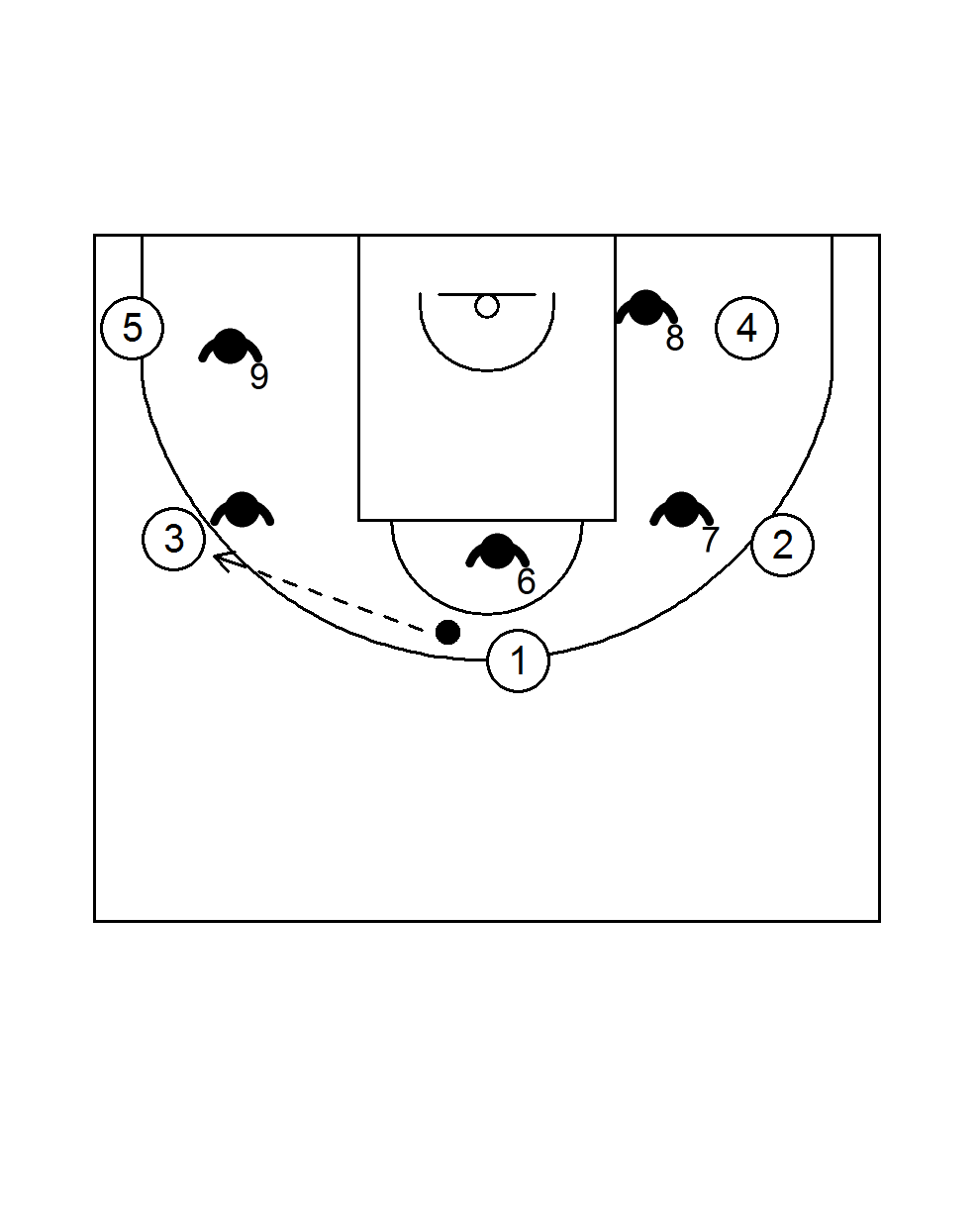
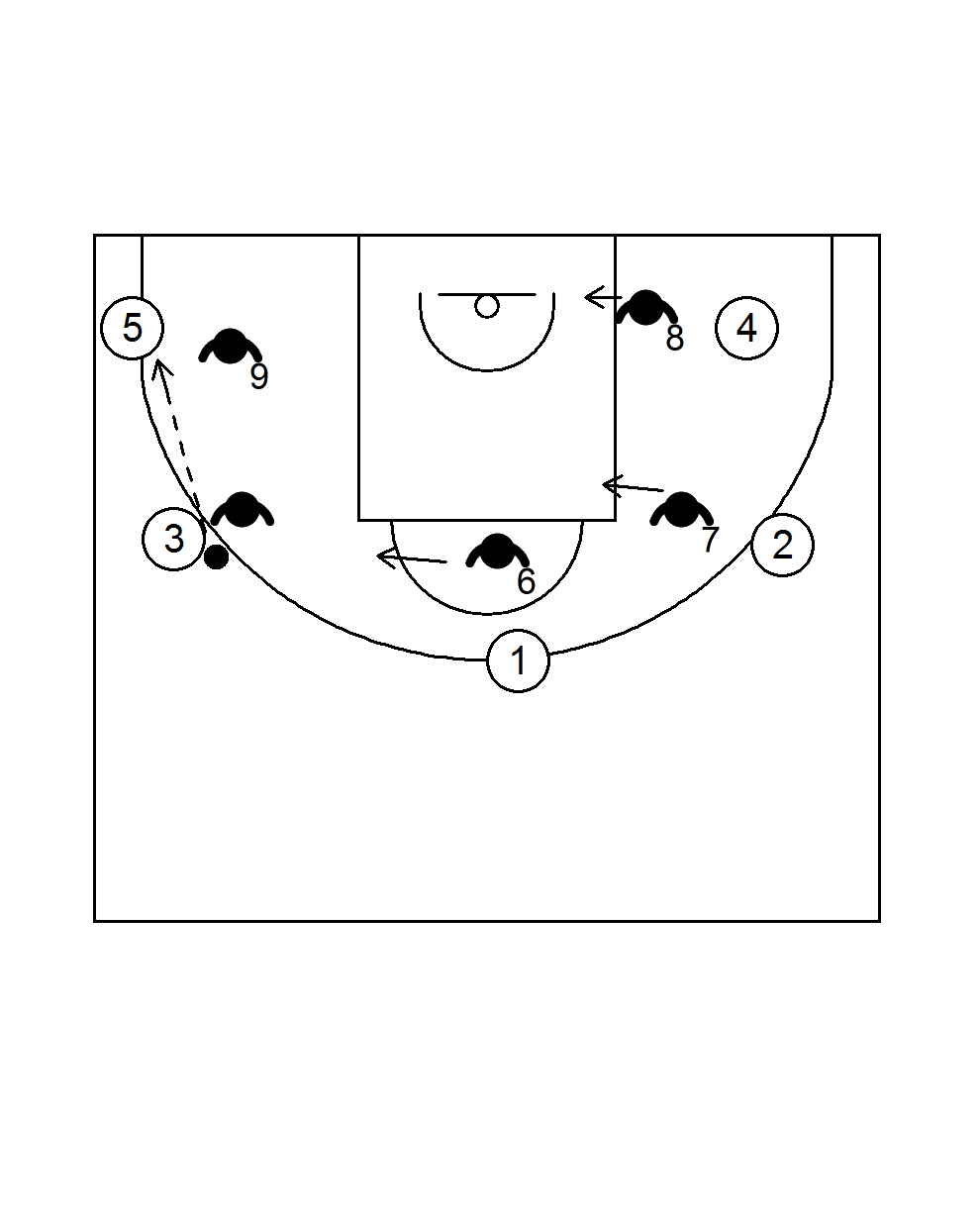
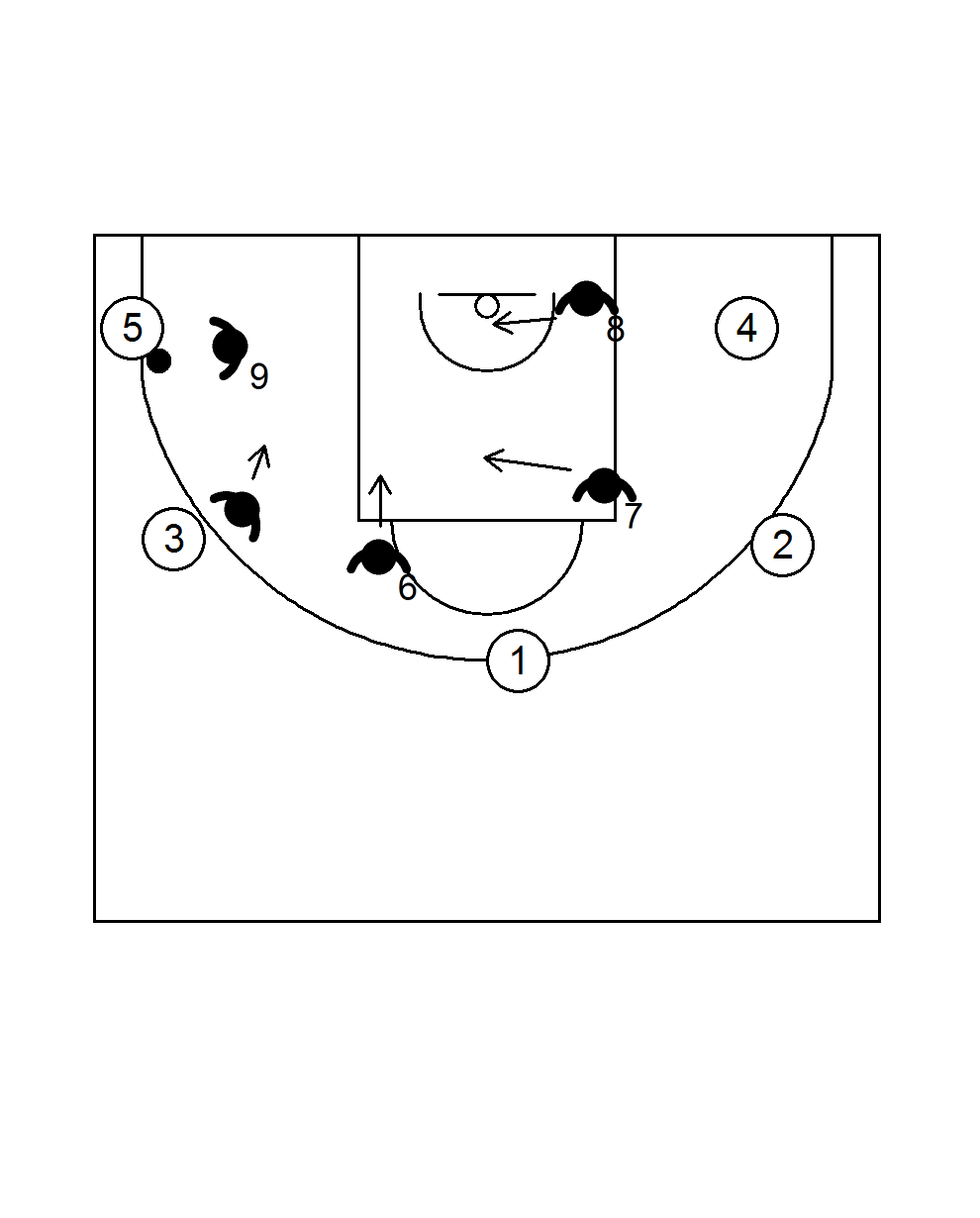
Prerequisites:
players must understand the principles of help side and ball side defense
Goal:
To create automatisms in defence
Organization:
5 against 5 on one basket
Successively:
- pass only
- pass + cut + fill in
- drive left + turn the wheel and the same player does a back up dribble + drive right + turn the wheel
- then he passes and cuts to the weak side
- the same with a skip pass after the two drives
- centre comes in from the weak side = catching and forcing a cut to the back
- both forwards cut in from the weak side in quick succession
Variation:
- play with 4 out
- allow the first pass to the centre
- Defender of the center takes up his position between man and basket while the ball is in the air with a hop.
- passer cuts past the post
- centre passes out to the head
Teaching points:
- all defenders move to their new position while the ball is in the air
- cutting in after a pass = jump to the ball - catch with the chest and force the ball to be cut in behind you
- cutting in from the weak side catch the player with your forearm and force him to cut behind you
- recover immediately after you have helped and the ball is passed out
- aggressive sprint + mini slides + sitting deep at close out after skip pass
- centre passes to the head = his defender has to be 'up the line and on the line
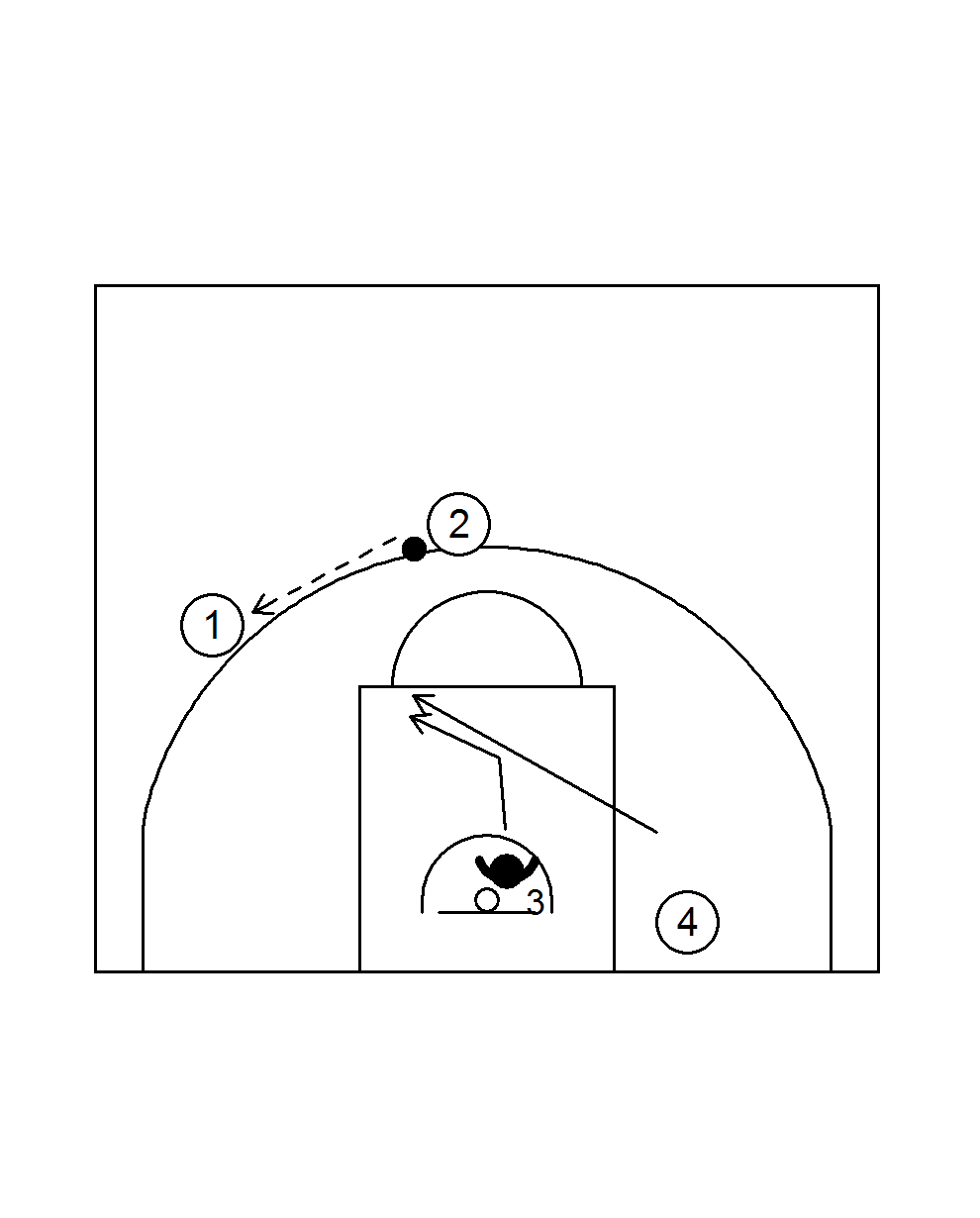
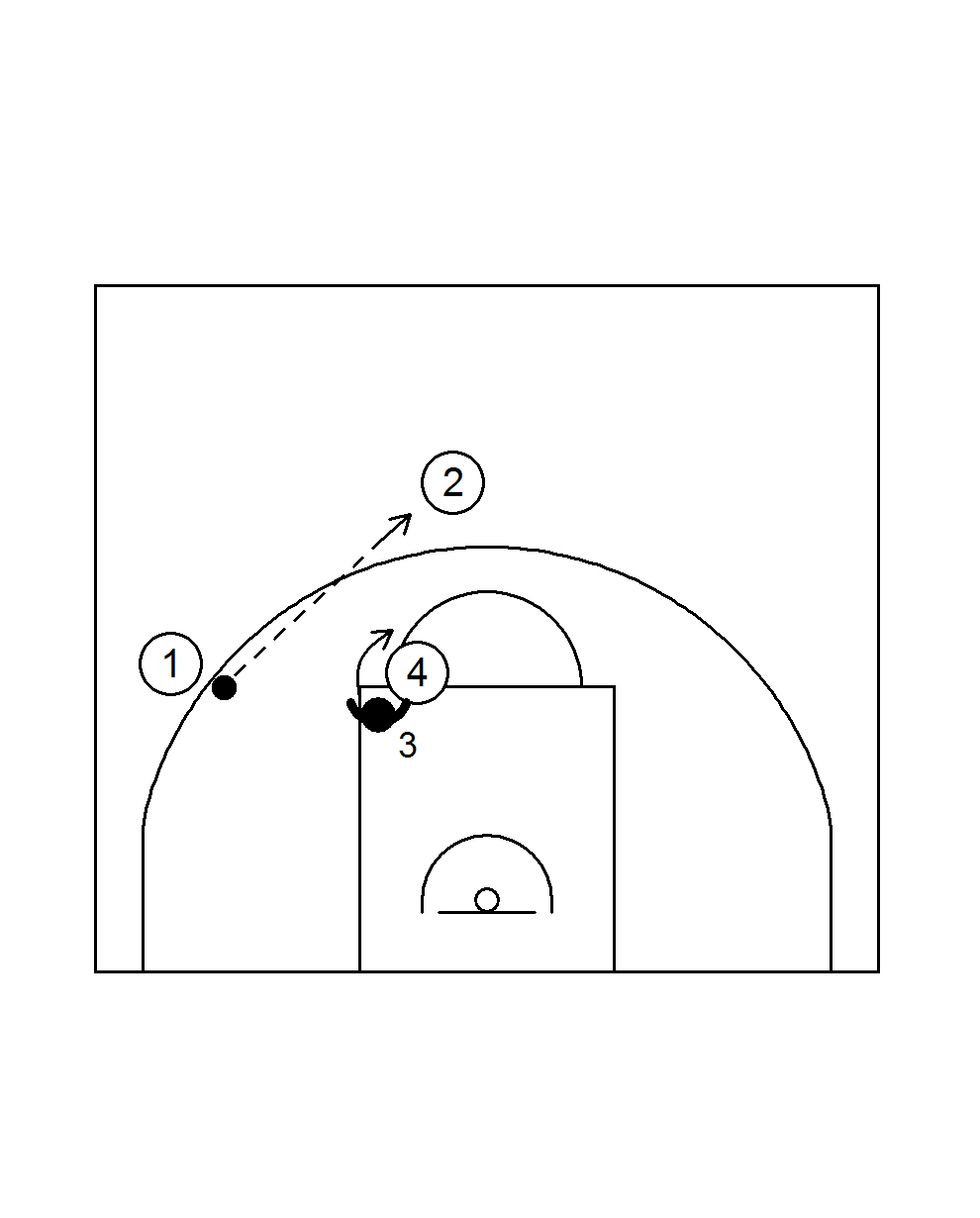
Goal: high post permanent replay after pass between forward and guard
Organisation:
- attacker 4 offers himself at the elbow at the moment of the pass
- defender 3 passes with his back to the baseline
- when passing back to the guard, defender 3 steps in front (here: right foot) and passes to the other side
- attackers 1 and 2 try to adjust high post 4 on the elbow
- if they cannot do so within 2 seconds, they must pass back to each other Each passis a point for the defender.
- if 4 is matched, he gets a point and plays 1 against 1 against 3
- the winner gets another point
- play to the 5
Teaching Points:
- feet on both sides of the high post
- keep the elbow cylinder
- prevent the pass on the high post with the other hand.
Variations:
passers parallel to side of bucket and center asks at the mid post
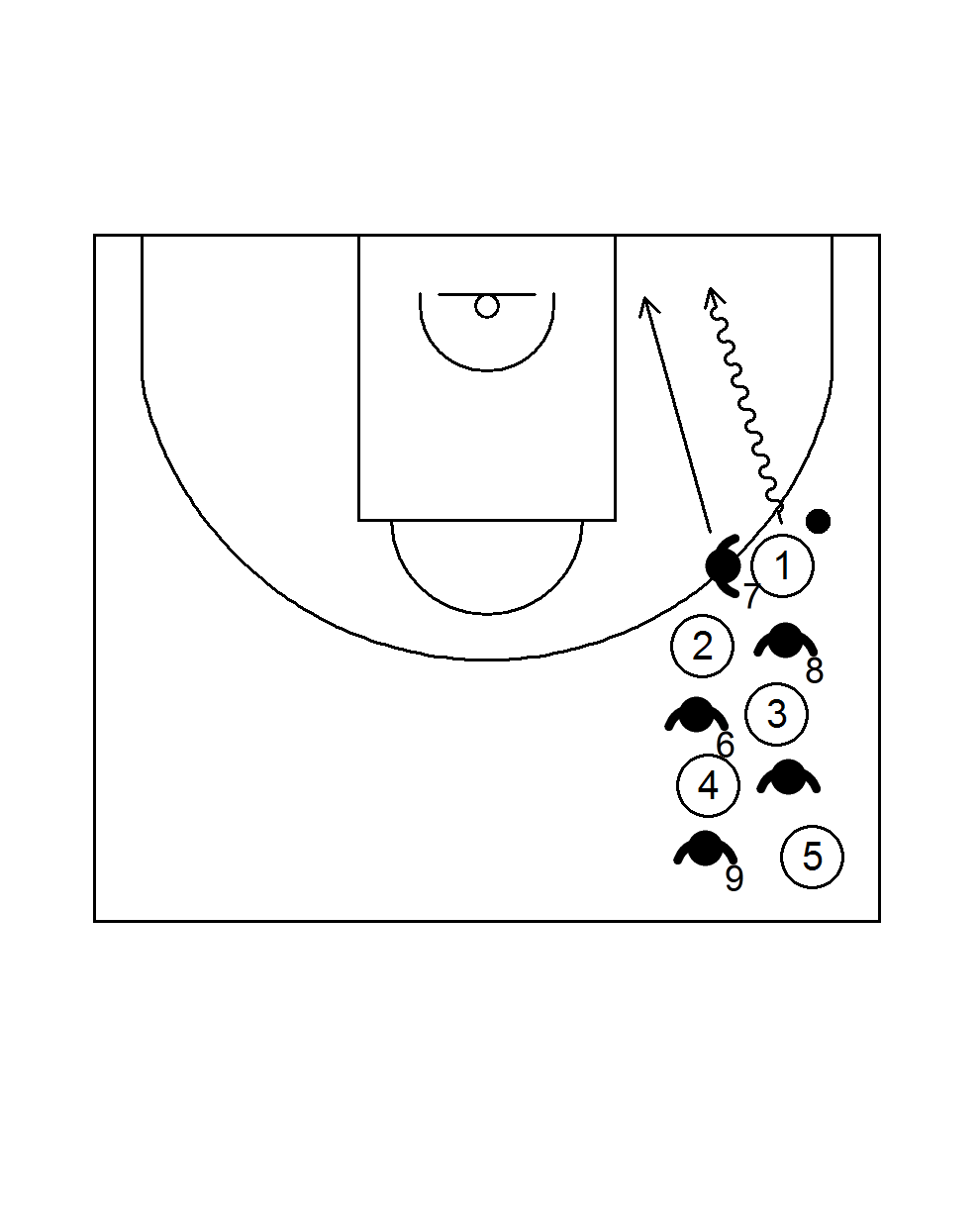
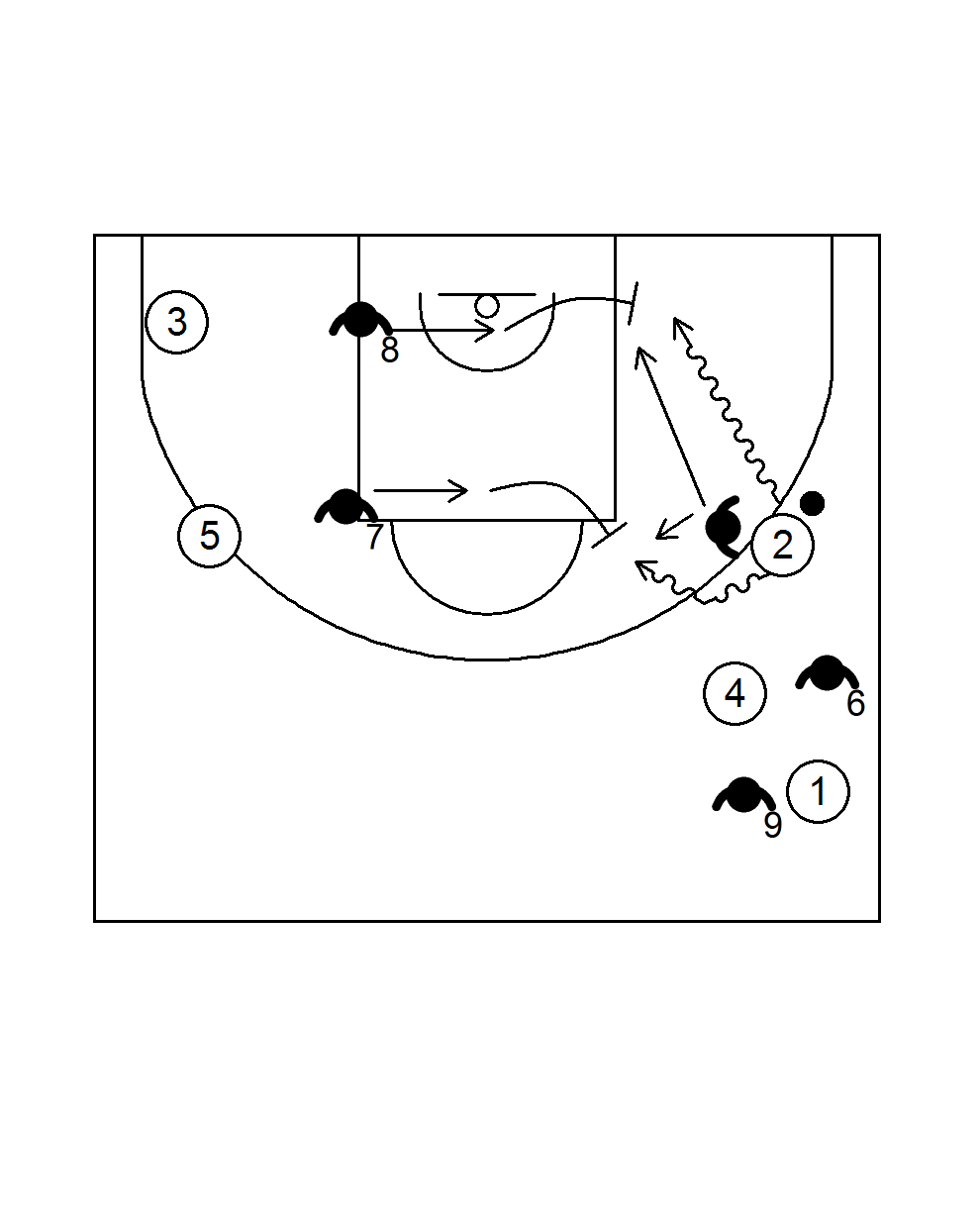
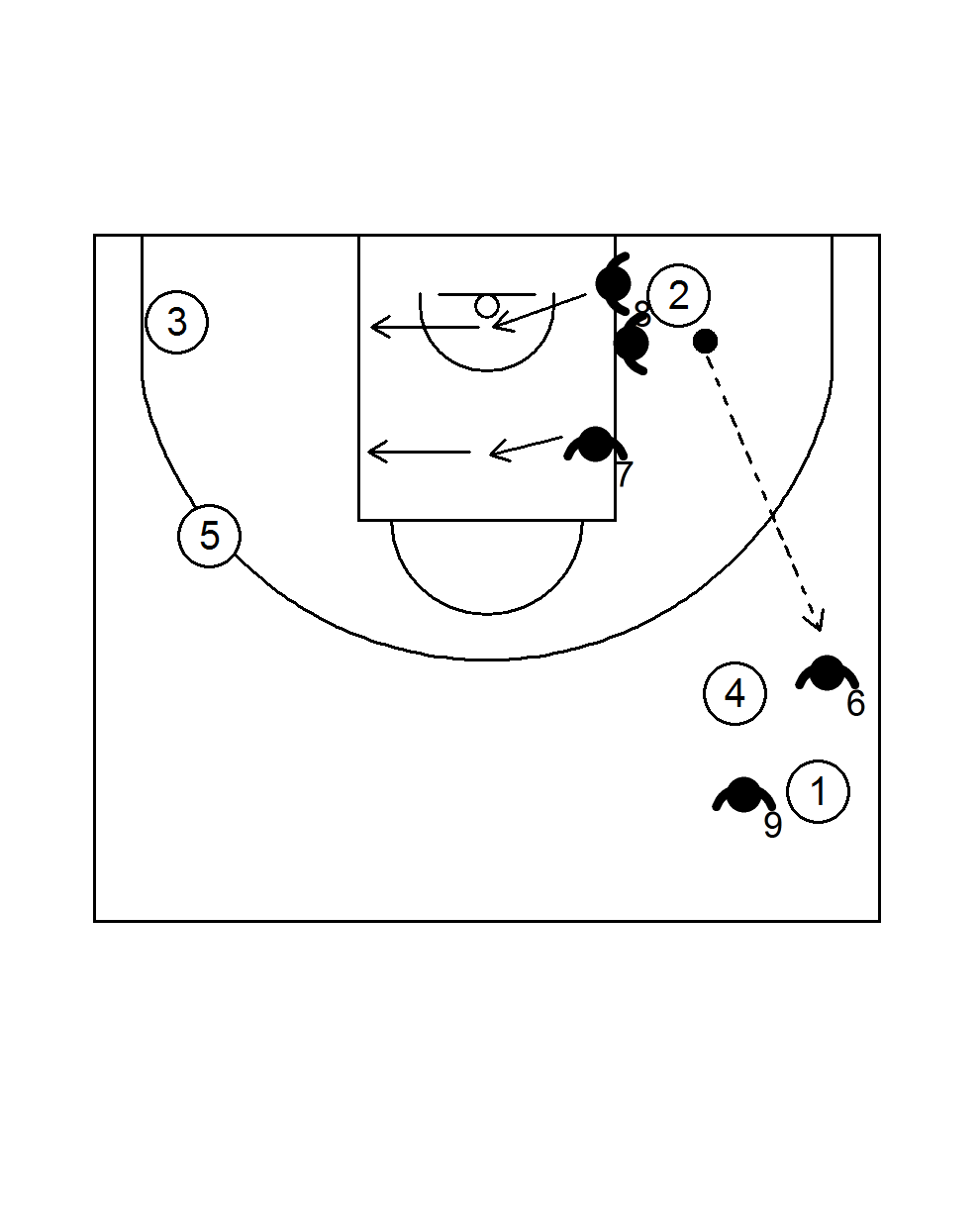
Prerequisites:
players must know how to use slides and sprints to keep their position between man and basket
Objective:
to teach positioning in the help side
Organisation:
- in the waiting line white and black take turns; offensive and defensive
- stop at the side of the bucket, pass the ball backwards to the next player
- closing the back and changing roles (attacker and defender).
Teaching Points:
- forearm on the hip of the dribbler
- sit deep
- Keep your nose in front of the ball
- Make sure you stay between man and basket until you get below the block
With two defenders on the help side:
- The help side defenders start with one foot in the bucket.
- As soon as the dribbler goes below the free throw line, both help side defenders step in until they reach the helpline.
- when the dribbler passes his man, they close the way to the basket (under the block or above the elbow)
RECOVERY:
- Â- as soon as the dribbler picks up the ball they sprint back to their position on the helpline
- Â- if he passes the ball back to the guard line, then the help position side bucket
Teaching points:
- defend close to the dribbler; don't leave room for feints
- only really help to stop the dribbler after he has passed his man
- but at all times prevent the dribbler from entering the bucket.
- recover immediately after you have helped and the ball is picked up or passed to the passer
- in the assisting position, your chest is parallel to the imaginary line between the ball and your man
- Split vision: see the ball AND your own man
- until you actually start to help Then you let go of your man and concentrate fully on stopping the dribbler
- when the ball is passed out, all defenders move to their new position while it is in the air
Rotation:
dribbler 2 and his defender take the bottom positions is3
and 8 go up5
and 7 join the back row the
defenders on the weak side are always the same colour as the defender on ball side
Variation:
- start with a skip pass
- 4 starts from the helpline
Teaching points for the recovery and close out:
- sprint two steps towards your man
- then use minislides to reduce the distance to an arm's length while lowering your hips.
- raise one hand to be able to block the shot
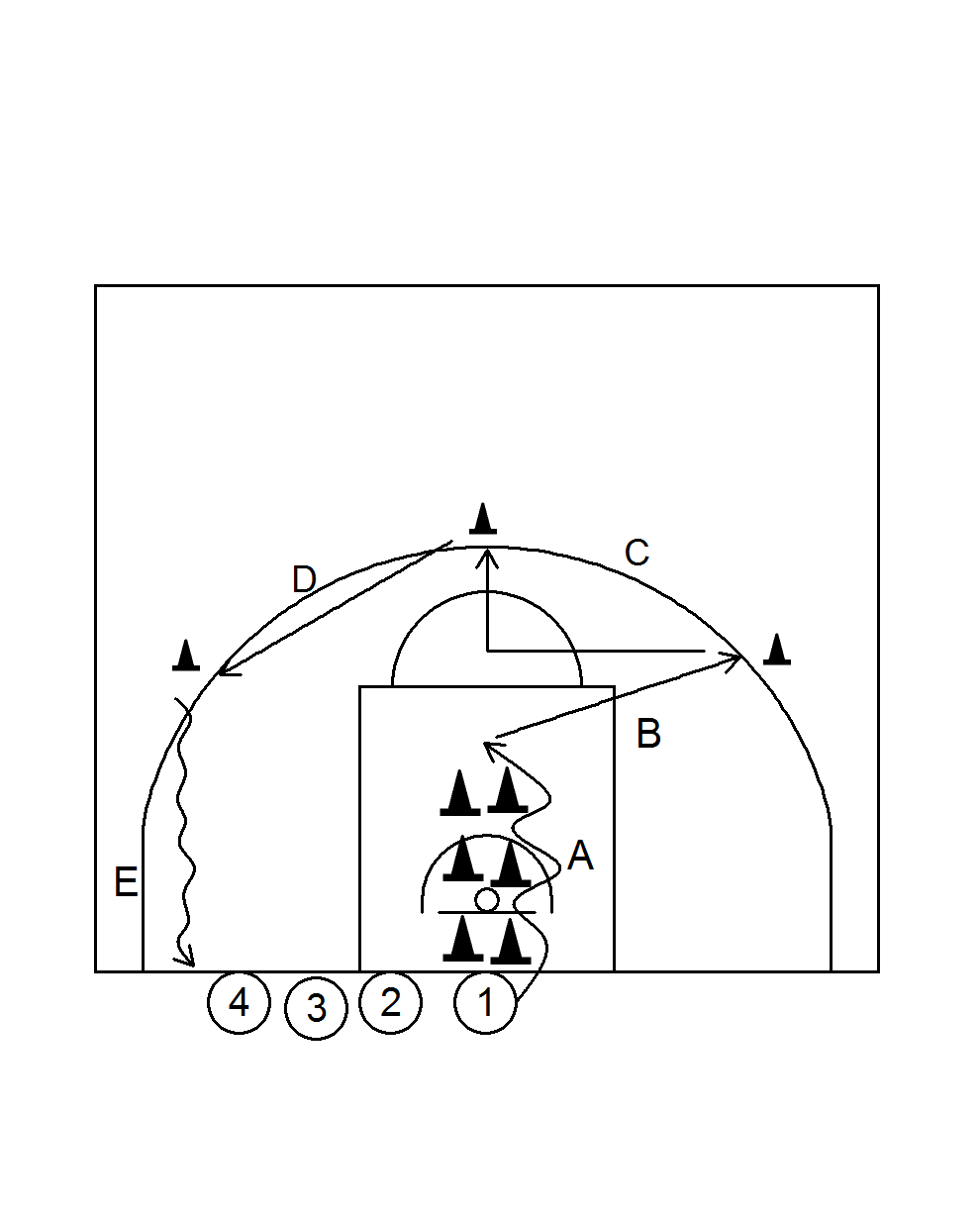
Prerequisites:
players must master slides and a close out of the shooter
Objective:
- to instill good defensive footwork
- increase speed and flexibility of footwork, plus fitness
Organization:
always 3 minutes
A jump strength
- start in defensive stance
- take off with two feet, jump high over the cones (try to touch your chest with your knees)
- land in balance, spring through the knees, feet at shoulder width
- and jump directly over the next cones.
B close out weak side shooter
- two explosive sprint steps, then lower your hips a bit + reduce step size
- inside foot in front
- outside hand in the face of the archer
- Touch the pawn with your inside hand (= check that you are sitting deep enough)
- take off with 2 feet and jump as high as possible with both arms stretched to block the imaginary shot
C help stopping penetration of the guard
- two explosive sprint steps, then lower your hips a bit + reduce step size + turn a quarter
- feet parallel
- arms wide
- quick step straight forward + pull in the back foot (in the game when the guard stops and shoots)
- tap the pawn with your hand
- push off with 2 feet and jump as high as possible with both arms extended to block the imaginary shot.
D defend the dribbler
- land in defensive stance
- powerful sllide steps to just in front of the pawn
- arms wide
- touch the pawn with your outside hand (= check that your seat is deep enough)
- take off with 2 feet and jump as high as possible with both arms stretched to block the imaginary shot
E turn the hips
- Face and chest parallel to the sideline.
- walk crosswise towards the backline
- alternately put the right foot in front of and behind the left leg
- while doing so the pelvis rotates which increases the flexibility of the hips.
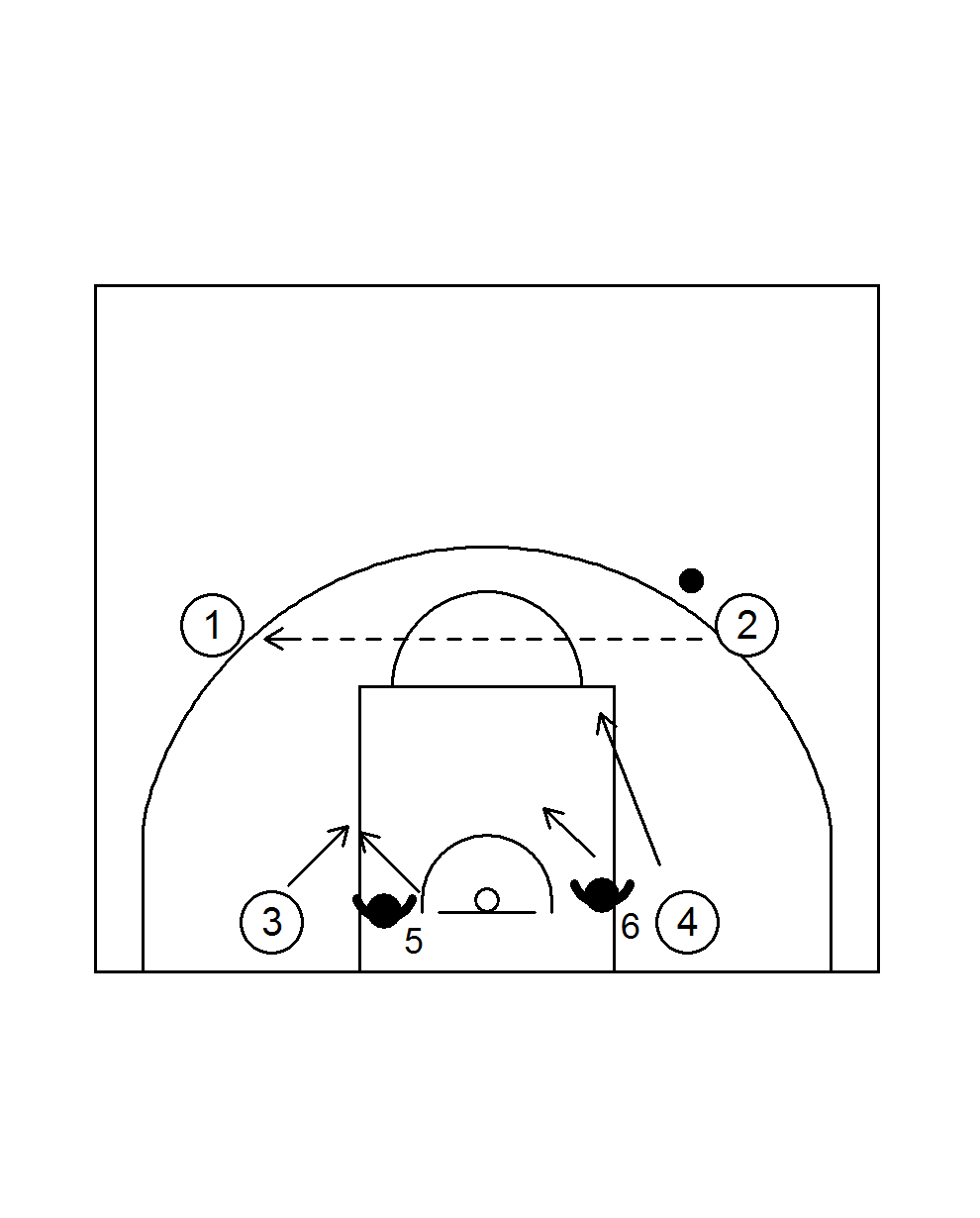
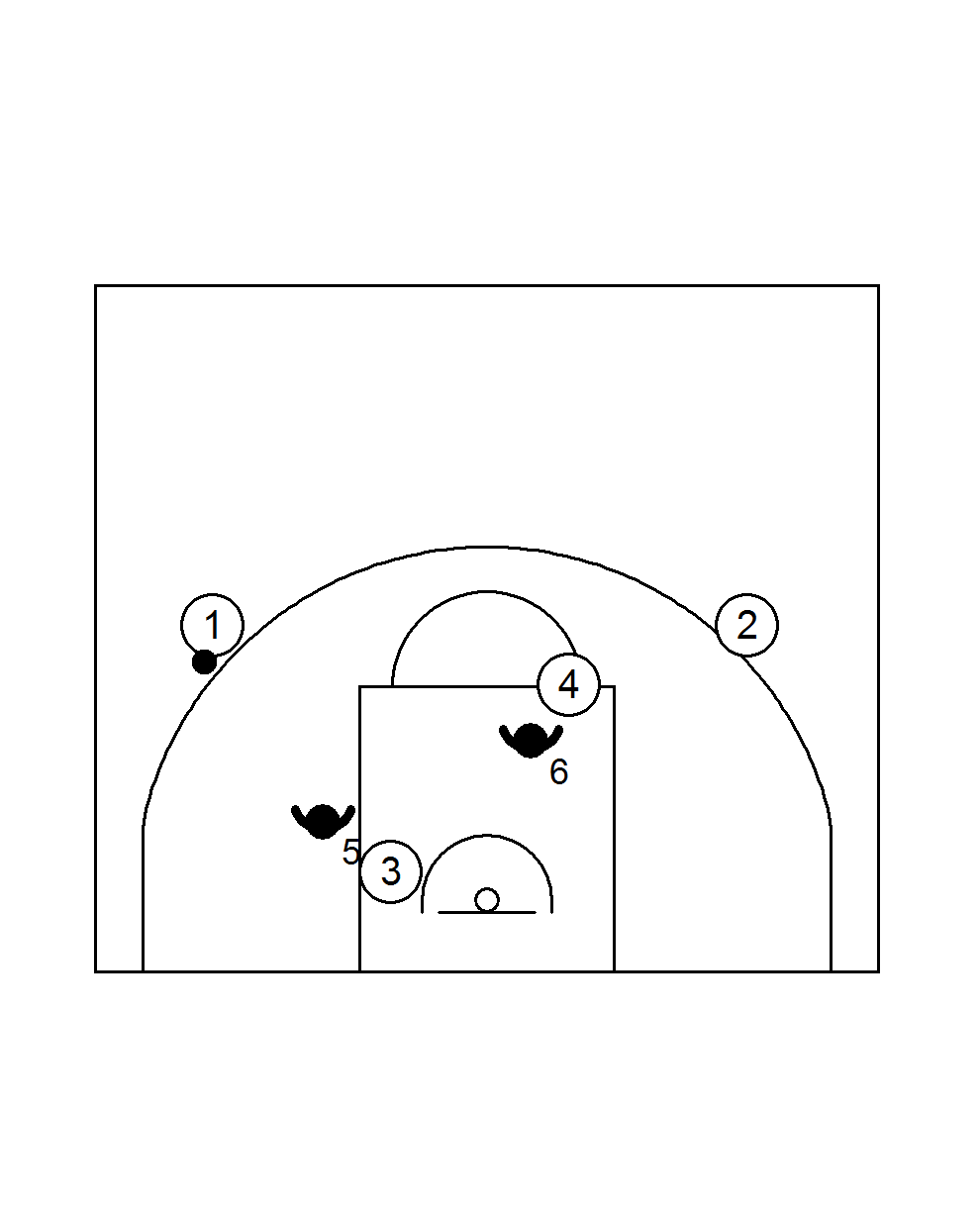
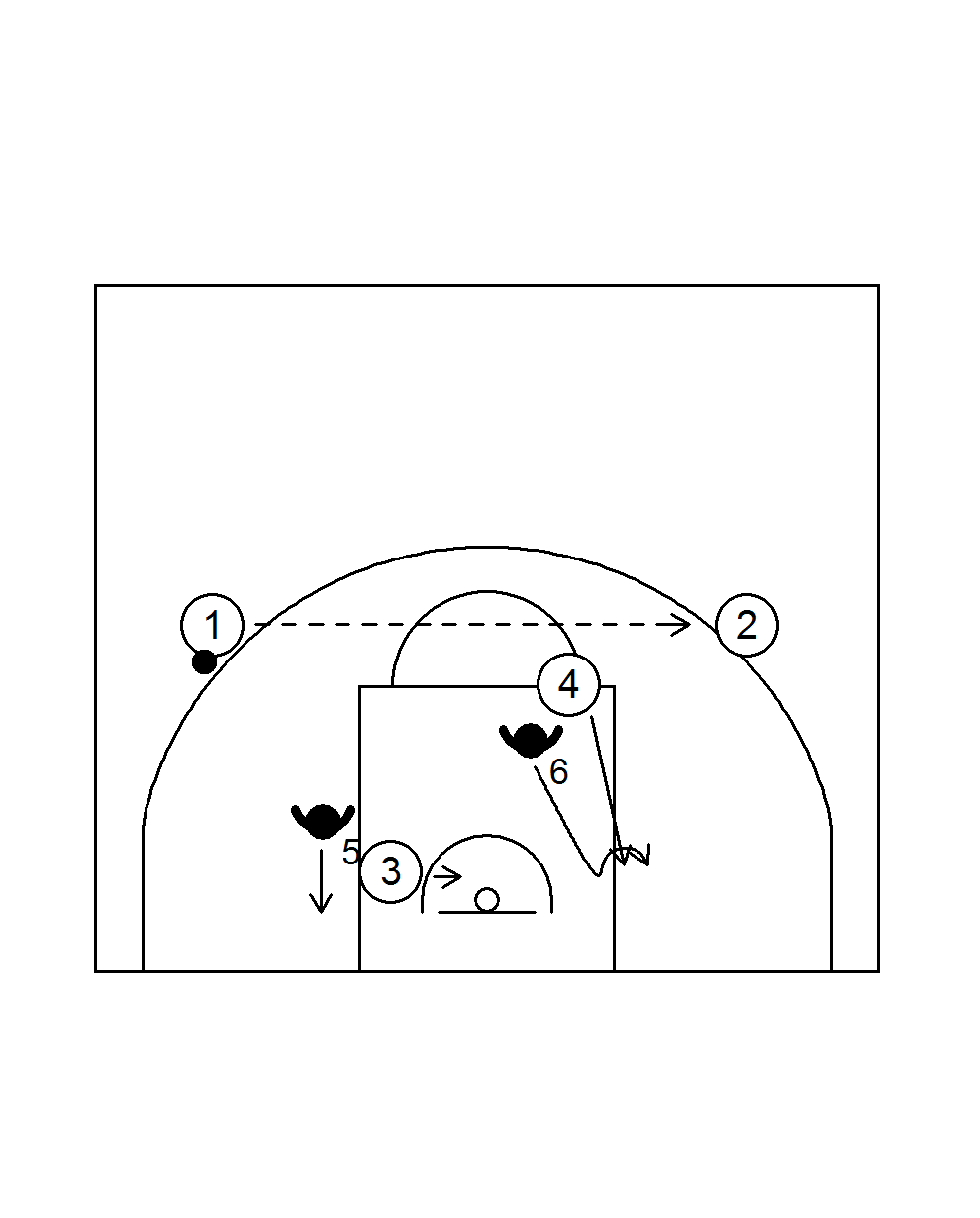
Goal: Defending the mid post in front if it threatens to get into the bucket
Organization:
- Forwards 1 and 2 may adjust a center. If they cannot do so within 2 seconds, they must pass to each other. They remain in place
- as soon as a center has the ball in or near the bucket, they play 2 against 2 and try to score (but passing is allowed)
- ball side defender plays denial defense
- weak side defender stands with 1 foot on the helpline
- as soon as the mid post on the ball side looks for a position on the edge of or in the bucket, defender 5 stands between attacker 3 and the ball
- at the moment of the lob pass, defender 6 should stand in the back of attacker 3 and try to force the attacking foul
- when attacker 3 passes to the high post, every defender looks for his own man
- every pass from forward to forward or a pass from a center back to the forward scores 1 point for the defenders
- a defensive rebound also scores 1 point
- for every score from the bucket you lose 2 points
- foul on a goalie = score
- On a swing, the hig post looks for a position on the block.
- Defender 6 stays between man and basket until the block.
- steps around attacker 4 along the top of the block (top foot first, then step around the block with the bottom foot).
Teaching Points:
- prevent the pass at the mid-post with 1 hand up
- with the other hand, feel which way the mid-post is moving.
- get as close to the attacker as possible (but make sure you can jump to intercept the pass)
- When switching from denial defense to frontal defense, first move the foot closest to the basket.
- then pull the other foot in
Variations:
put a defender at the forward to make the pass towards the mid post more difficult
Goal: frontal defense of the low post
Organization:
- Players 1 and 2 may adjust a center. If they cannot do so within 2 seconds, they must pass to each other. They remain at their place.
- The attacking centre asks the side of the bucket for the ball.
- defender must cross between the attacker and the free throw line
- and defend the attacker in front.
- every pass from forward to forward scores 1 point for the defender
- a defensive rebound also scores 1 point
- for every score from the bucket 1 point is deducted
- foul on a goalie = score
- play until the 3
Teaching Points:
- prevent the pass on the mid post with 1 hand up.
- Push the attacker backwards with the other forearm (but make sure you can jump to intercept the pass).
- face to the half way line







